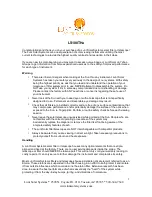
9
an observing site well away from light pollution. Take plenty
of time to let your eyes adjust to the darkness. Don’t expect
these subjects to appear like the photographs you see in
books and magazines; most will look like dim gray smudges.
(Our eyes are not sensitive enough to see color in such faint
objects.) But as you become more experienced and your
observing skills get sharper, you will be able to discern more
subtle details.
Remember that the higher the magnification you use, the dim-
mer the image will appear. So stick with low power when
observing deep-sky objects because they’re already very faint.
Consult a star atlas or observing guide for information on finding
and identifying deep-sky objects. Some good sources to start
with are the Orion DeepMap 600, Edmund Mag 6 Star Atlas,
Turn Left at Orion, and The Universe From Your Backyard.
7. terrestrial Viewing
The Observer 60 EQ Ultra may also be used for long-dis-
tance viewing over land. For this application we recommend
substitution of an Orion 45° Correct-Image Diagonal (#8792)
for the 90° star diagonal that comes standard with the tele-
scope. The correct-image diagonal will yield an upright,
nonreversed image and also provides a more comfortable
viewing angle, since the telescope will be aimed more hori-
zontally for terrestrial subjects.
For terrestrial viewing, it’s best to stick with low powers of 50x
or less. At higher powers the image loses sharpness and
clarity. That’s because when the scope is pointed near the
horizon, it is peering through the thickest and most turbulent
part of the Earth’s atmosphere.
iMPortant:
Remember to aim well clear of the
Sun, unless the front of the telescope is fitted with a
professionally made solar filter and the finder scope is
covered with foil or some other completely opaque
material.
8. care and Maintenance
If you give your telescope reasonable care, it will last a life-
time. Store it in a clean, dry, dust-free place, safe from rapid
changes in temperature and humidity. Do not store the tele-
scope outdoors, although storage in a garage or shed is OK.
Small components like eyepieces and other accessories
should be kept in a protective box or storage case. Keep the
objective lens cap on the front of the telescope when it is not
in use.
Your Observer 60 EQ Ultra requires very little mechanical
maintenance. The optical tube is aluminum and has a smooth
painted finish that is fairly scratch-resistant. If a scratch does
appear on the tube, it will not harm the telescope. If you wish,
you may apply some auto touch-up paint to the scratch.
Smudges on the tube can be wiped off with a soft cloth and
a household cleaner such as Windex or Formula 409.
cleaning the optics
A small amount of dust or a few specks on the glass objective
(main) lens will not affect the performance of the telescope. If
dust builds up, however, simply blow it off with a blower bulb,
or lightly brush it off with a soft camel-hair brush. Avoid touch-
ing optical surfaces with your fingers, as skin oil may etch
optical coatings.
To remove fingerprints or smudges from a lens, use photo-
graphic-type lens cleaning fluid and lint-free optical lens
cleaning tissue. Don’t use household cleaners or eyeglass-
type cleaning cloth or wipes, as they often contain undesirable
additives like silicone, which don’t work well on precision
optics. Place a few drops of fluid on the tissue (not directly on
the lens), wipe gently, then remove the fluid with a dry tissue
or two. Do not “polish” or rub hard when cleaning the lens, as
this will scratch it. The tissue may leave fibers on the lens, but
this is not a problem; they can be blown off with a blower bulb.
Note: Never disassemble the telescope or eyepieces to
clean optical surfaces!
9. specifications
Objective lens: 60mm-diameter (2.4") achromat, magne-
sium fluoride-coated
Focal length: 900mm
Focal ratio: f/15
Eyepieces: 25mm and 9mm Kellner, fully coated, 1.25"
Magnification: 36x (25mm), 100x (9mm)
Finder scope: 6x magnification, 30mm aperture, achromat
Diagonal: 90° star diagonal, prism type, hybrid .965"/1.25"
Mount: German-type equatorial






















